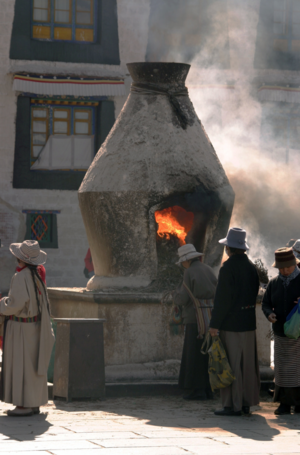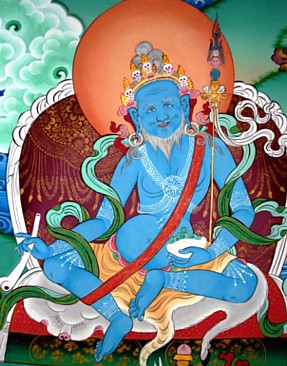Riwo Sangchö

Riwo Sangchö (Tib. རི་བོ་བསང་མཆོད་, Wyl. ri bo bsang mchod), or literally ‘Mountain Smoke Offering’, is a famous practice of sang offering. It is a terma that was hidden by Guru Rinpoche and revealed in the seventeenth century by the great yogin and tertön Lhatsün Namkha Jikmé (1597-1653), who brought the Dharma to Sikkim, as part of the profound Dharma-cycle of Rigdzin Sokdrup, Accomplishing the Life-Force of the Vidyadharas. From the many ways, elaborate or condensed, of doing this practice, Dudjom Rinpoche composed an abbreviated version for daily practice, this is what is followed by the Rigpa sangha.
Purpose
The purpose of Riwo Sangchö is to realize the perfection of wisdom, by accumulating merits through two main aspects of practice: offerings, and purification—especially of impurity and of obstructions.[1]
According to Dodrupchen Jikmé Tenpé Nyima[2]
- It is by making illusory offerings through illusory practice that we can complete the gathering of illusory accumulations. Through this cause—namely the accumulation of merit—we can gain the result, which is the perfection of wisdom. Four such methods which involve very little difficulty and yet are exceptionally meaningful and beneficial are the offerings of sang, water tormas, sur and one’s own body. The individual who practises these regularly and diligently will gather the accumulations, purify the obscurations, and, in particular, will pacify any obstacles and factors that prevent the accomplishment of the Dharma and awakening in the present lifetime, becoming free of them like the sun emerging from the clouds. Since they also support our progress along the path leading to the supreme attainment of Dzogpachenpo, it makes sense for us to put our energy into practising them.
According to Gyalsé Shenpen Tayé[3]:
- […] The four naturally pure universal elements—earth, water, fire and wind—provide numerous methods for purifying or cleansing the stains of both temporary and ultimate obscuration… This practice [of sang offering] could be described as a method using the element of fire in particular in order to purify obscurations until all temporary and ultimate defilements have been cleared away.
According to Lama Tharchin Rinpoche[4]
- Riwo Sangchö comes from the viewpoint of Dzogchen. It is really the best practice to remove obstacles and fulfil both temporary and long-term wishes. The smoke offering is made to all wisdom beings, to the Three Jewels, the Three Roots and Dharma Protectors, and the Three Kayas. Offering to the wisdom beings helps us to accumulate merit and wisdom. This brings short-term happiness and ultimate enlightenment. We also offer to all demonic beings who are actually manifestations of our karmic debt. These karmic debtors cause obstacles of all kinds, both temporary in this life and also long-term obstacles to enlightenment. Through this offering, karmic debtors are repaid, removing all of these obstacles. This is really the best technique.
According to Orgyen Topgyal Rinpoche[5]:
- When we pray to Guru Rinpoche and invoke his blessing, offer sang and engage in other practices that cause the flourishing of lung ta, we awaken the clarity aspect of the mind. We awaken our rigpa, so that it is more perceptible to us. The ultimate point of such practice is to awaken the clarity aspect of our minds, to bring us into closer contact with our own rigpa. We may even discover the enlightened intent of kadak or ‘primordial purity’, where neither suffering nor even the concept of suffering remain to be dealt with.
Content

The practice of the Riwo Sangchö has three sections:
1. The Preliminaries
- Taking refuge
- Generating the awakened mind, the heart of Bodhichitta
- Seven branch offering
- [Self visualization][6]
- [Purification and blessing of the sang offering]
2. The Main Part
- Blessing the offering substances
- The recipients of the offerings
- How the offering is made
3. The Conclusion
- Dedication
- Aspiration
- Requesting activity
Revelation of the Terma
Lhatsün Namkha Jikmé was an incarnation of both Vimalamitra and Longchenpa. His most important teachers were the two great vidyadharas Jatsön Nyingpo and Rigdzin Düddul Dorje.
In 1646, at their urging, following a prophecy that to do so would be of great benefit for the Dharma throughout the Himalayas, Lhatsün Namkha Jikmé went on foot to Lhari Ösel Nyingpo in Sikkim. There, he founded a temple and hermitage, establishing it as one of the most sacred places of pilgrimage in the Himalayas. In accordance with an earlier prophetic declaration of the dakinis, the famous cycle of terma teachings called Rigdzin Sokdrup, ‘Accomplishing the Life-Force of the Vidyadharas’, emerged in a pure vision while he was in retreat in the cave of Dhaki-hying near Tashiding. These teachings, of which Riwo Sangchö form the mengak or ‘innermost instruction’, are unsurpassed instructions on Dzogchen Atiyoga.[7]
Propagation
Throughout Sikkim during the 17th
Through his practice of Riwo Sangchö since 1646, Lhatsün Namkha Jikmé was able to remove all human and non-human obstacles to the Dharma in Sikkim, and opened it as a ‘secret land’ of the teachings. Because of this, he was able to teach Dzogchen very widely there and established an unbroken lineage that continues to this day, known simply as “Sikkim Dzogchen“. Rigdzin Sokdrup, ‘Accomplishing the Life-Force of the Vidyadharas’, continues to be transmitted and practised throughout Tibet and particularly in Sikkim.
Throughout the Himalayas during the 18th,19th and 20th century
While there exist many other sang offering practices, the Riwo Sangchö became maybe the most widely practised within all different lineages of Tibetan Buddhism.
In the West since the 1970’s
In the West, during the 1970’s, Dudjom Rinpoche made an arrangement of the original practice of Riwo Sangchö and practised it daily, encouraging all his students to do so.
Benefits
Through his practice of Riwo Sangchö, Lhatsün Namkha Jikmé was able to remove all human and non-human obstacles to the Dharma in Sikkim, and opened it as a hidden-land of the teachings.
Lama Tharchin Rinpoché said ‘Dudjom Rinpoche did this practice all the time and recommended it to all of his students. In my life, I have had such success with this practice of Riwo Sangchö, and recommend it to all my spiritual friends and vajra brothers and sisters.’[8]
According to Sogyal Rinpoche, "Dudjom Rinpoche always used to do this practice every morning. This is an incredible and powerful practice. Everything is dissolving into rainbow light. You need to feel that in your practice."
Text
 Root text: Mountain Smoke Offering, revealed by Lhatsün Namkha Jikmé from Accomplishing the Life Force of the Vidyadharas
Root text: Mountain Smoke Offering, revealed by Lhatsün Namkha Jikmé from Accomplishing the Life Force of the Vidyadharas
Commentaries
 The Gentle Rain of Benefit and Joy—An Explanation of the Practice of Sang Offering by Gyalsé Shenpen Tayé
The Gentle Rain of Benefit and Joy—An Explanation of the Practice of Sang Offering by Gyalsé Shenpen Tayé Guide to Sang Practice by Dodrupchen Jikmé Tenpé Nyima
Guide to Sang Practice by Dodrupchen Jikmé Tenpé Nyima
Further Reading
- A Guide to Vajrayana Practice for the Rigpa Sangha, Section 3. Riwo Sangchö (based on teachings by Orgyen Tobgyal Rinpoche and commentaries by Gyalsé Shenpen Tayé and Dodrupchen Jikmé Tenpé Nyima), The Tertön Sogyal Trust, 2006
Oral Teachings Given to the Rigpa Sangha
Sogyal Rinpoche's main teachings on Riwo Sangchö:
- Tuncurry, Australia, 10-11 March 2011
- Kirchheim, Germany, 1 January 2009
- Myall Lakes, Australia, 9-10 February 2008
- Lerab Ling, France, 24 April 2007
- Lerab Ling, France, 19 & 22 August 2006
Other teachers:
- Ian Maxwell: Kirchheim, 1 January 2004 and Lerab Ling, 24 August 2003.
Edited Teachings of Sogyal Rinpoche
- Riwo Sangchö and Tendrel Nyesel—Making your Practice Meaningful (available in English, French and German, DVE 500)
- Dzogchenlinks July & September 2011, The Deep Significance of Riwo Sangchö Practice (Parts 1 & 2) [based on Sogyal Rinpoche's teachings in Tuncurry, Australia, 2012]
- Dzogchenlink, Nov. 2007, The Practice of Riwo Sangchö part 2
- Dzogchenlink, Sept. 2007, The Practice of Riwo Sangchö part 1
- Dzogchenlink, Nov. 1998, The Practice of Riwo Sangchö
Notes
- ↑ reference needed
- ↑ Dodrupchen Jikmé Tenpé Nyima, ‘Guide to Sang Practice’, translated by Adam Pearcey.
- ↑ Gyalsé Shenpen Tayé, The Gentle Rain of Benefit and Joy—An Explanation of the Practice of Sang Offering, translated by Adam Pearcey.
- ↑ Lama Tharchin Rinpoche, ‘Instructions on The Mountain Smoke Offering‘, email communication, Vajrayana Foundation
- ↑ A Guide to Vajrayana Practice for the Rigpa Sangha, Section 3. Riwo Sangchö (based on teachings by Orgyen Tobgyal Rinpoche and commentaries by Gyalsé Shenpen Tayé and Dodrupchen Jikmé Tenpé Nyima), The Tertön Sogyal Trust, 2006.
- ↑ According to Orgyen Topgyal Rinpoche, ‘For this version of the Riwo Sangchö, Dudjom Rinpoche selected texts from the self-visualization from Rigdzin Sokdrup, the terma of Lhatsün Namkha Jikmé, which is included in the Rinchen Terdzö, in the section on sang and sur offerings. In fact, the prayers that Dudjom Rinpoche added for visualization, the purification and blessing of the sang offering were all composed before his time. He did not ‘invent’ anything himself.
- ↑ Riwo Sangchö and Lung Ta, Essential Guides to the Daily Sadhana Practices of the Rigpa Sangha.
- ↑ Lama Tharchin Rinpoche, ‘Instructions on The Mountain Smoke Offering, email communication, Vajrayana Foundation